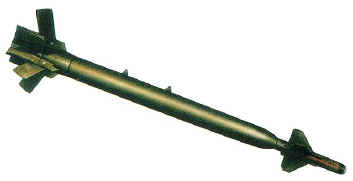The US military wants to develop non-nuclear weapons to
penetrate deep bunkers. The largest "bunker buster" in service is
the GBU-28,
a 4640 lb bomb that is basically an 8-inch artillery tube filled with
explosives. (below) After a decade of testing, the US military is unable to
improve on this design. The basic problem is the high speed impact causes explosives
to detonate on the surface, and larger bombs cannot be carried by the F-15. A
newer type of thermobaric "fuel-air" bomb called the BLU-118/B
has been developed, as well as a 21,000 lb MOAB super bomb for the
B-2, but neither are capable of deep penetration.
The solution is two-fold. First, use C-17 transports to drop the bomb. They can lift 150,000 lbs a good distance, so a much larger bomb can be dropped that provides greater penetration because of the greater terminal velocity and mass. The second solution is not to use explosives. The kinetic energy from a large object can provide great destruction as the impact that created the "Meteor Crater" in Arizona proves. (below) Ben Rich in his book "Skunk Works" relates how Lockheed tried to convince US Air Force generals that slim, solid steel bombs dropped from an F-12 (SR-71 fighter version) at 80,000 ft didn't need an explosive filler. They wouldn't or couldn't accept the idea. The impact velocity of ~Mach 2 is where a projectile with a solid mass yields more kinetic energy than the lesser mass of a hollow bomb plus the chemical energy from its explosive filler.
Nevertheless, a solid steel "Meteor Bomb" will be more effective if the back end is filled with standard jet fuel to provide a secondary benefit. The aft half of the the long metal bomb will break on impact so that jet fuel pours down the hole made by the solid steel forward half of the "big telephone pole" bomb. When needed, it will be loaded aboard a C-17, fitted with a guidance system (no fuze required), then an aircraft refueling truck tanks it up. It can be dropped at 30,000 feet and guided by a laser or GPS signal like current precision bombs, or by a bombardier using fiber optic guidance.
 Upon impact, the massive steel dart
punches
deep into earth or through several floors of a big bunker. The impact causes the thin casing of the upper portion of the bomb to break, spewing
fuel everywhere behind the steel dart. Burning jet fuel is destructive and
will quickly burn up
all oxygen in a bunker the massive steel dart penetrates.
Upon impact, the massive steel dart
punches
deep into earth or through several floors of a big bunker. The impact causes the thin casing of the upper portion of the bomb to break, spewing
fuel everywhere behind the steel dart. Burning jet fuel is destructive and
will quickly burn up
all oxygen in a bunker the massive steel dart penetrates.
This will be the world's safest bomb to store and move since it has no explosives. It needn't be stored in bunkers or even guarded. It will be world's the largest and cheapest bomb since it just a big steel telephone pole with a hollow back end. Therefore, C-17s can drop these like test wells just to see if a bunker is there. If they happen to hit a chemical or biological storage site, the jet fuel can burn up most of the hazardous material. Meteor bombs can also destroy entire office buildings by punching through dozens of floors and setting the entire building ablaze. The secret to the ultimate bunker bomb is simple, don't use explosives, use flaming meteors.
©2015 www.G2mil.com